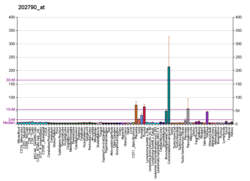CLDN7
Claudin-7 is a protein that in humans is encoded by the CLDN7 gene.[5][6] It belongs to the group of claudins.
Claudins, such as CLDN7, are involved in the formation of tight junctions between epithelial cells. Tight junctions restrict lateral diffusion of lipids and membrane proteins, and thereby physically define the border between the apical and basolateral compartments of epithelial cells (Zheng et al., 2003).[supplied by OMIM][6]
References
- ENSG00000288292 GRCh38: Ensembl release 89: ENSG00000181885, ENSG00000288292 - Ensembl, May 2017
- GRCm38: Ensembl release 89: ENSMUSG00000018569 - Ensembl, May 2017
- "Human PubMed Reference:". National Center for Biotechnology Information, U.S. National Library of Medicine.
- "Mouse PubMed Reference:". National Center for Biotechnology Information, U.S. National Library of Medicine.
- Morita K, Furuse M, Fujimoto K, Tsukita S (Mar 1999). "Claudin multigene family encoding four-transmembrane domain protein components of tight junction strands". Proc Natl Acad Sci U S A. 96 (2): 511–6. doi:10.1073/pnas.96.2.511. PMC 15167. PMID 9892664.
- "Entrez Gene: CLDN7 claudin 7".
External links
- Human CLDN7 genome location and CLDN7 gene details page in the UCSC Genome Browser.
Further reading
- Kniesel U, Wolburg H (2000). "Tight junctions of the blood–brain barrier". Cell. Mol. Neurobiol. 20 (1): 57–76. doi:10.1023/A:1006995910836. PMID 10690502.
- Heiskala M, Peterson PA, Yang Y (2001). "The roles of claudin superfamily proteins in paracellular transport". Traffic. 2 (2): 93–8. doi:10.1034/j.1600-0854.2001.020203.x. PMID 11247307.
- Tsukita S, Furuse M, Itoh M (2001). "Multifunctional strands in tight junctions". Nat. Rev. Mol. Cell Biol. 2 (4): 285–93. doi:10.1038/35067088. PMID 11283726.
- Tsukita S, Furuse M (2003). "Claudin-based barrier in simple and stratified cellular sheets". Curr. Opin. Cell Biol. 14 (5): 531–6. doi:10.1016/S0955-0674(02)00362-9. PMID 12231346.
- González-Mariscal L, Betanzos A, Nava P, Jaramillo BE (2003). "Tight junction proteins". Prog. Biophys. Mol. Biol. 81 (1): 1–44. doi:10.1016/S0079-6107(02)00037-8. PMID 12475568.
- Maruyama K, Sugano S (1994). "Oligo-capping: a simple method to replace the cap structure of eukaryotic mRNAs with oligoribonucleotides". Gene. 138 (1–2): 171–4. doi:10.1016/0378-1119(94)90802-8. PMID 8125298.
- Suzuki Y, Yoshitomo-Nakagawa K, Maruyama K, et al. (1997). "Construction and characterization of a full length-enriched and a 5'-end-enriched cDNA library". Gene. 200 (1–2): 149–56. doi:10.1016/S0378-1119(97)00411-3. PMID 9373149.
- Peacock RE, Keen TJ, Inglehearn CF (1998). "Analysis of a human gene homologous to rat ventral prostate.1 protein". Genomics. 46 (3): 443–9. doi:10.1006/geno.1997.5033. PMID 9441748.
- Itoh M, Furuse M, Morita K, et al. (2000). "Direct Binding of Three Tight Junction-Associated Maguks, Zo-1, Zo-2, and Zo-3, with the Cooh Termini of Claudins". J. Cell Biol. 147 (6): 1351–63. doi:10.1083/jcb.147.6.1351. PMC 2168087. PMID 10601346.
- Strausberg RL, Feingold EA, Grouse LH, et al. (2003). "Generation and initial analysis of more than 15,000 full-length human and mouse cDNA sequences". Proc. Natl. Acad. Sci. U.S.A. 99 (26): 16899–903. doi:10.1073/pnas.242603899. PMC 139241. PMID 12477932.
- Kominsky SL, Argani P, Korz D, et al. (2003). "Loss of the tight junction protein claudin-7 correlates with histological grade in both ductal carcinoma in situ and invasive ductal carcinoma of the breast". Oncogene. 22 (13): 2021–33. doi:10.1038/sj.onc.1206199. PMID 12673207.
- Ban Y, Dota A, Cooper LJ, et al. (2003). "Tight junction-related protein expression and distribution in human corneal epithelium". Exp. Eye Res. 76 (6): 663–9. doi:10.1016/S0014-4835(03)00054-X. PMID 12742348.
- Zheng JY, Yu D, Foroohar M, et al. (2004). "Regulation of the expression of the prostate-specific antigen by claudin-7". J. Membr. Biol. 194 (3): 187–97. doi:10.1007/s00232-003-2038-4. PMID 14502431.
- Resnick MB, Konkin T, Routhier J, et al. (2005). "Claudin-1 is a strong prognostic indicator in stage II colonic cancer: a tissue microarray study". Mod. Pathol. 18 (4): 511–8. doi:10.1038/modpathol.3800301. PMID 15475928.
- Liu F, Koval M, Ranganathan S, Fanayan S, Hancock WS, Lundberg EK, Beavis RC, Lane L, Duek P, McQuade L, Kelleher NL, Baker MS (2015). "A systems proteomics view of the endogenous human claudin protein family". J Proteome Res. doi:10.1021/acs.jproteome.5b00769. PMC 4777318. PMID 26680015.
This article is issued from Wikipedia. The text is licensed under Creative Commons - Attribution - Sharealike. Additional terms may apply for the media files.




